E151 Public Health and Social Care Placement Learning Assessment 2
VerifiedAdded on 2024/05/21
|13
|3885
|258
Report
AI Summary
This report provides a reflective account of placement learning in the field of public health and social care. It includes a personal profile detailing the skills and knowledge acquired during the placement, such as dedication, decision-making, and the ability to identify and develop opportunities. The report also discusses the application of these skills in professional practice, emphasizing the importance of confidence, quality service delivery, and staff retention. Furthermore, it explores the impact of this learning on personal development, highlighting the ability to work in teams, maintain composure under stress, and demonstrate empathy. The report also examines public health initiatives (PHI), including their aims, objectives, and implementation strategies for addressing global health challenges like maternal health, tuberculosis, HIV/AIDS, and malnutrition. The report concludes by summarizing the learning outcomes achieved during the placement, emphasizing the importance of these experiences for future professional growth. Desklib offers a wealth of similar resources, including past papers and solved assignments, to support students in their academic endeavors.
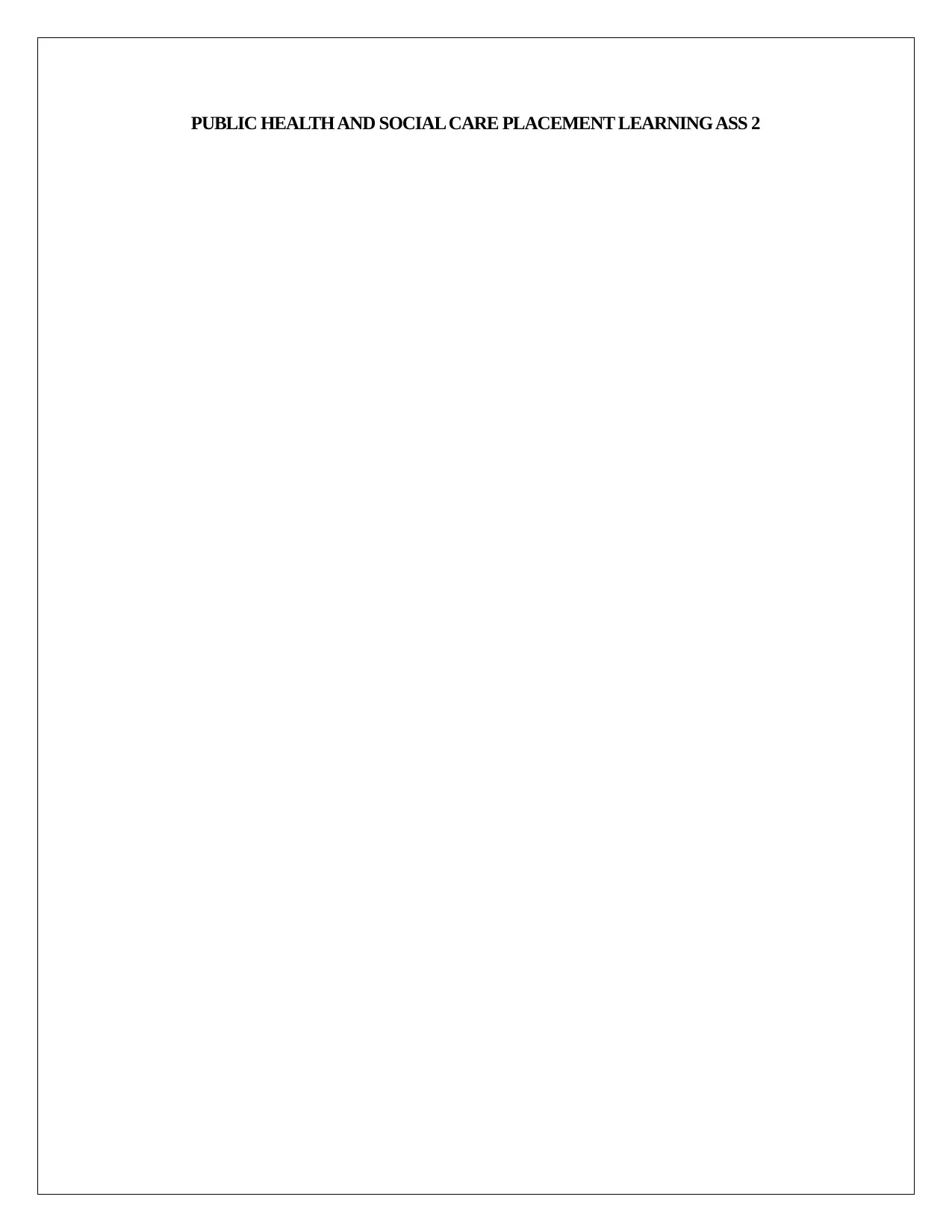
PUBLIC HEALTH AND SOCIAL CARE PLACEMENT LEARNING ASS 2
Paraphrase This Document
Need a fresh take? Get an instant paraphrase of this document with our AI Paraphraser
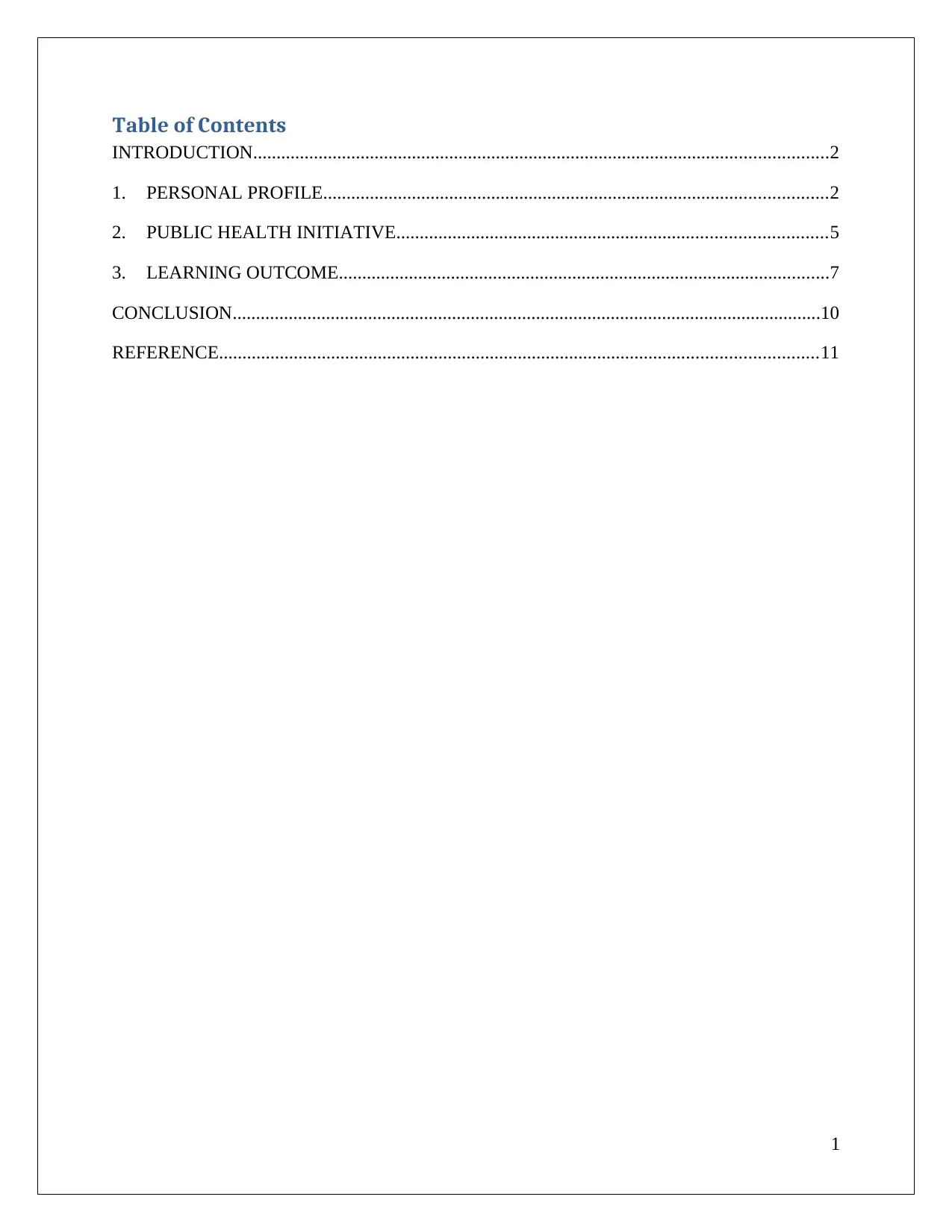
Table of Contents
INTRODUCTION...........................................................................................................................2
1. PERSONAL PROFILE............................................................................................................2
2. PUBLIC HEALTH INITIATIVE............................................................................................5
3. LEARNING OUTCOME.........................................................................................................7
CONCLUSION..............................................................................................................................10
REFERENCE................................................................................................................................11
1
INTRODUCTION...........................................................................................................................2
1. PERSONAL PROFILE............................................................................................................2
2. PUBLIC HEALTH INITIATIVE............................................................................................5
3. LEARNING OUTCOME.........................................................................................................7
CONCLUSION..............................................................................................................................10
REFERENCE................................................................................................................................11
1
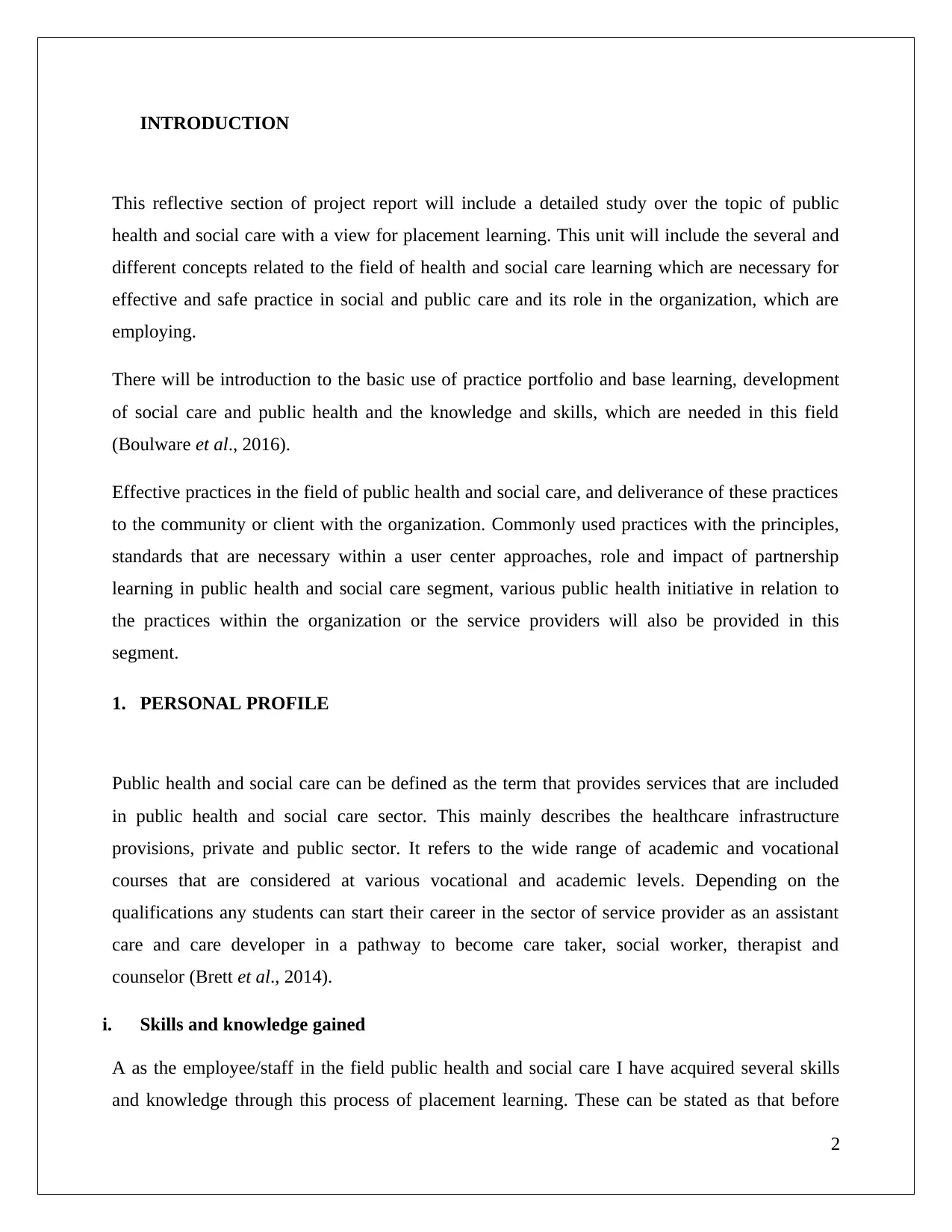
INTRODUCTION
This reflective section of project report will include a detailed study over the topic of public
health and social care with a view for placement learning. This unit will include the several and
different concepts related to the field of health and social care learning which are necessary for
effective and safe practice in social and public care and its role in the organization, which are
employing.
There will be introduction to the basic use of practice portfolio and base learning, development
of social care and public health and the knowledge and skills, which are needed in this field
(Boulware et al., 2016).
Effective practices in the field of public health and social care, and deliverance of these practices
to the community or client with the organization. Commonly used practices with the principles,
standards that are necessary within a user center approaches, role and impact of partnership
learning in public health and social care segment, various public health initiative in relation to
the practices within the organization or the service providers will also be provided in this
segment.
1. PERSONAL PROFILE
Public health and social care can be defined as the term that provides services that are included
in public health and social care sector. This mainly describes the healthcare infrastructure
provisions, private and public sector. It refers to the wide range of academic and vocational
courses that are considered at various vocational and academic levels. Depending on the
qualifications any students can start their career in the sector of service provider as an assistant
care and care developer in a pathway to become care taker, social worker, therapist and
counselor (Brett et al., 2014).
i. Skills and knowledge gained
A as the employee/staff in the field public health and social care I have acquired several skills
and knowledge through this process of placement learning. These can be stated as that before
2
This reflective section of project report will include a detailed study over the topic of public
health and social care with a view for placement learning. This unit will include the several and
different concepts related to the field of health and social care learning which are necessary for
effective and safe practice in social and public care and its role in the organization, which are
employing.
There will be introduction to the basic use of practice portfolio and base learning, development
of social care and public health and the knowledge and skills, which are needed in this field
(Boulware et al., 2016).
Effective practices in the field of public health and social care, and deliverance of these practices
to the community or client with the organization. Commonly used practices with the principles,
standards that are necessary within a user center approaches, role and impact of partnership
learning in public health and social care segment, various public health initiative in relation to
the practices within the organization or the service providers will also be provided in this
segment.
1. PERSONAL PROFILE
Public health and social care can be defined as the term that provides services that are included
in public health and social care sector. This mainly describes the healthcare infrastructure
provisions, private and public sector. It refers to the wide range of academic and vocational
courses that are considered at various vocational and academic levels. Depending on the
qualifications any students can start their career in the sector of service provider as an assistant
care and care developer in a pathway to become care taker, social worker, therapist and
counselor (Brett et al., 2014).
i. Skills and knowledge gained
A as the employee/staff in the field public health and social care I have acquired several skills
and knowledge through this process of placement learning. These can be stated as that before
2
⊘ This is a preview!⊘
Do you want full access?
Subscribe today to unlock all pages.

Trusted by 1+ million students worldwide
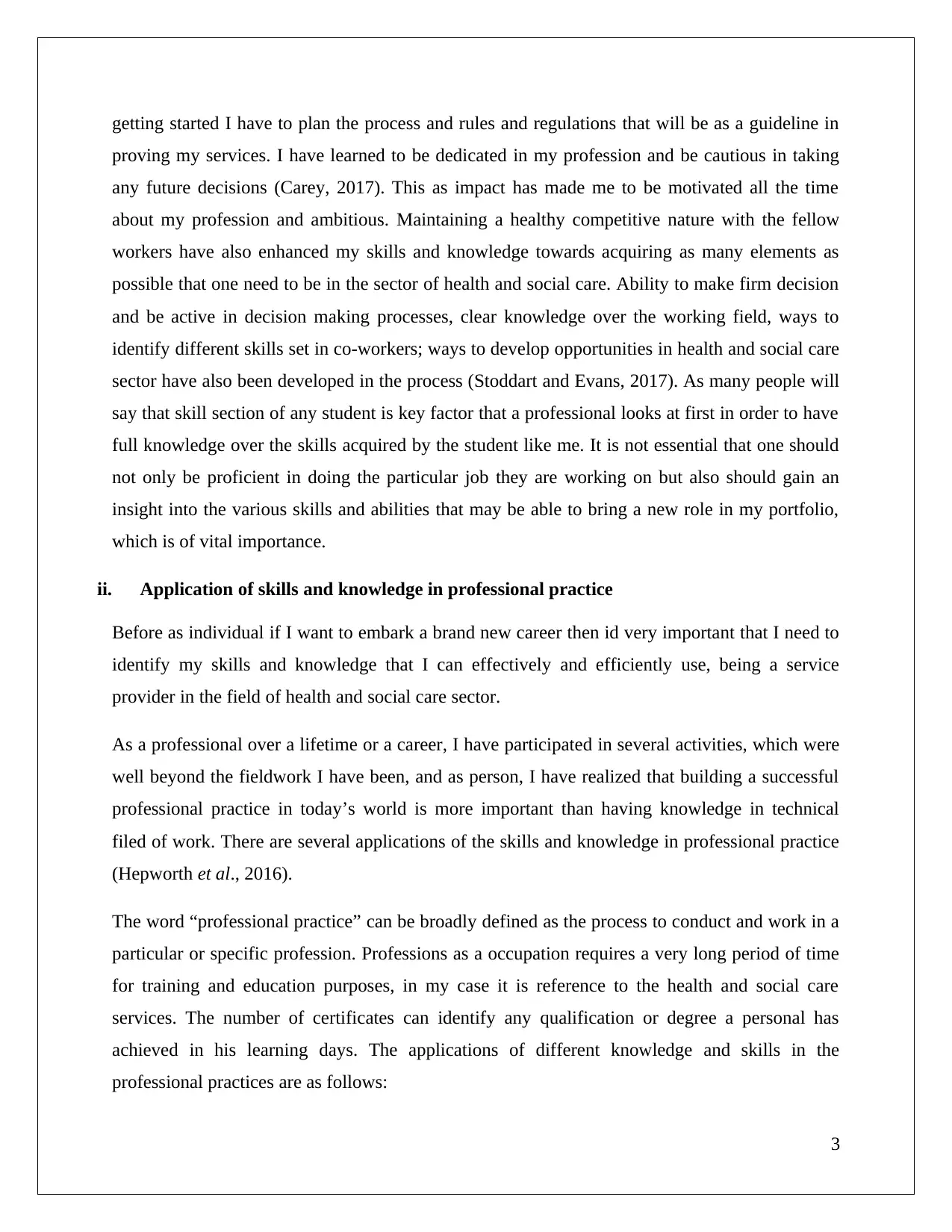
getting started I have to plan the process and rules and regulations that will be as a guideline in
proving my services. I have learned to be dedicated in my profession and be cautious in taking
any future decisions (Carey, 2017). This as impact has made me to be motivated all the time
about my profession and ambitious. Maintaining a healthy competitive nature with the fellow
workers have also enhanced my skills and knowledge towards acquiring as many elements as
possible that one need to be in the sector of health and social care. Ability to make firm decision
and be active in decision making processes, clear knowledge over the working field, ways to
identify different skills set in co-workers; ways to develop opportunities in health and social care
sector have also been developed in the process (Stoddart and Evans, 2017). As many people will
say that skill section of any student is key factor that a professional looks at first in order to have
full knowledge over the skills acquired by the student like me. It is not essential that one should
not only be proficient in doing the particular job they are working on but also should gain an
insight into the various skills and abilities that may be able to bring a new role in my portfolio,
which is of vital importance.
ii. Application of skills and knowledge in professional practice
Before as individual if I want to embark a brand new career then id very important that I need to
identify my skills and knowledge that I can effectively and efficiently use, being a service
provider in the field of health and social care sector.
As a professional over a lifetime or a career, I have participated in several activities, which were
well beyond the fieldwork I have been, and as person, I have realized that building a successful
professional practice in today’s world is more important than having knowledge in technical
filed of work. There are several applications of the skills and knowledge in professional practice
(Hepworth et al., 2016).
The word “professional practice” can be broadly defined as the process to conduct and work in a
particular or specific profession. Professions as a occupation requires a very long period of time
for training and education purposes, in my case it is reference to the health and social care
services. The number of certificates can identify any qualification or degree a personal has
achieved in his learning days. The applications of different knowledge and skills in the
professional practices are as follows:
3
proving my services. I have learned to be dedicated in my profession and be cautious in taking
any future decisions (Carey, 2017). This as impact has made me to be motivated all the time
about my profession and ambitious. Maintaining a healthy competitive nature with the fellow
workers have also enhanced my skills and knowledge towards acquiring as many elements as
possible that one need to be in the sector of health and social care. Ability to make firm decision
and be active in decision making processes, clear knowledge over the working field, ways to
identify different skills set in co-workers; ways to develop opportunities in health and social care
sector have also been developed in the process (Stoddart and Evans, 2017). As many people will
say that skill section of any student is key factor that a professional looks at first in order to have
full knowledge over the skills acquired by the student like me. It is not essential that one should
not only be proficient in doing the particular job they are working on but also should gain an
insight into the various skills and abilities that may be able to bring a new role in my portfolio,
which is of vital importance.
ii. Application of skills and knowledge in professional practice
Before as individual if I want to embark a brand new career then id very important that I need to
identify my skills and knowledge that I can effectively and efficiently use, being a service
provider in the field of health and social care sector.
As a professional over a lifetime or a career, I have participated in several activities, which were
well beyond the fieldwork I have been, and as person, I have realized that building a successful
professional practice in today’s world is more important than having knowledge in technical
filed of work. There are several applications of the skills and knowledge in professional practice
(Hepworth et al., 2016).
The word “professional practice” can be broadly defined as the process to conduct and work in a
particular or specific profession. Professions as a occupation requires a very long period of time
for training and education purposes, in my case it is reference to the health and social care
services. The number of certificates can identify any qualification or degree a personal has
achieved in his learning days. The applications of different knowledge and skills in the
professional practices are as follows:
3
Paraphrase This Document
Need a fresh take? Get an instant paraphrase of this document with our AI Paraphraser
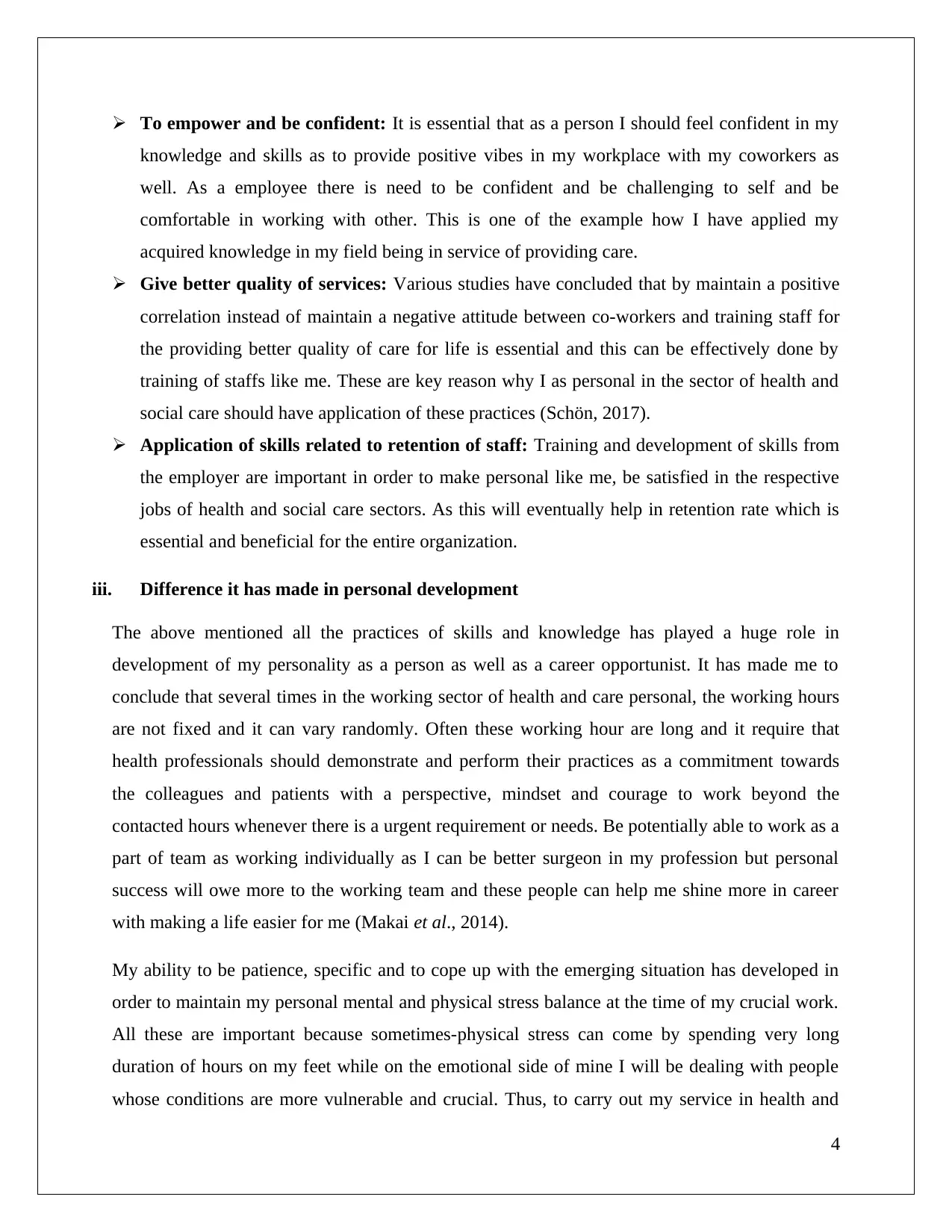
To empower and be confident: It is essential that as a person I should feel confident in my
knowledge and skills as to provide positive vibes in my workplace with my coworkers as
well. As a employee there is need to be confident and be challenging to self and be
comfortable in working with other. This is one of the example how I have applied my
acquired knowledge in my field being in service of providing care.
Give better quality of services: Various studies have concluded that by maintain a positive
correlation instead of maintain a negative attitude between co-workers and training staff for
the providing better quality of care for life is essential and this can be effectively done by
training of staffs like me. These are key reason why I as personal in the sector of health and
social care should have application of these practices (Schön, 2017).
Application of skills related to retention of staff: Training and development of skills from
the employer are important in order to make personal like me, be satisfied in the respective
jobs of health and social care sectors. As this will eventually help in retention rate which is
essential and beneficial for the entire organization.
iii. Difference it has made in personal development
The above mentioned all the practices of skills and knowledge has played a huge role in
development of my personality as a person as well as a career opportunist. It has made me to
conclude that several times in the working sector of health and care personal, the working hours
are not fixed and it can vary randomly. Often these working hour are long and it require that
health professionals should demonstrate and perform their practices as a commitment towards
the colleagues and patients with a perspective, mindset and courage to work beyond the
contacted hours whenever there is a urgent requirement or needs. Be potentially able to work as a
part of team as working individually as I can be better surgeon in my profession but personal
success will owe more to the working team and these people can help me shine more in career
with making a life easier for me (Makai et al., 2014).
My ability to be patience, specific and to cope up with the emerging situation has developed in
order to maintain my personal mental and physical stress balance at the time of my crucial work.
All these are important because sometimes-physical stress can come by spending very long
duration of hours on my feet while on the emotional side of mine I will be dealing with people
whose conditions are more vulnerable and crucial. Thus, to carry out my service in health and
4
knowledge and skills as to provide positive vibes in my workplace with my coworkers as
well. As a employee there is need to be confident and be challenging to self and be
comfortable in working with other. This is one of the example how I have applied my
acquired knowledge in my field being in service of providing care.
Give better quality of services: Various studies have concluded that by maintain a positive
correlation instead of maintain a negative attitude between co-workers and training staff for
the providing better quality of care for life is essential and this can be effectively done by
training of staffs like me. These are key reason why I as personal in the sector of health and
social care should have application of these practices (Schön, 2017).
Application of skills related to retention of staff: Training and development of skills from
the employer are important in order to make personal like me, be satisfied in the respective
jobs of health and social care sectors. As this will eventually help in retention rate which is
essential and beneficial for the entire organization.
iii. Difference it has made in personal development
The above mentioned all the practices of skills and knowledge has played a huge role in
development of my personality as a person as well as a career opportunist. It has made me to
conclude that several times in the working sector of health and care personal, the working hours
are not fixed and it can vary randomly. Often these working hour are long and it require that
health professionals should demonstrate and perform their practices as a commitment towards
the colleagues and patients with a perspective, mindset and courage to work beyond the
contacted hours whenever there is a urgent requirement or needs. Be potentially able to work as a
part of team as working individually as I can be better surgeon in my profession but personal
success will owe more to the working team and these people can help me shine more in career
with making a life easier for me (Makai et al., 2014).
My ability to be patience, specific and to cope up with the emerging situation has developed in
order to maintain my personal mental and physical stress balance at the time of my crucial work.
All these are important because sometimes-physical stress can come by spending very long
duration of hours on my feet while on the emotional side of mine I will be dealing with people
whose conditions are more vulnerable and crucial. Thus, to carry out my service in health and
4
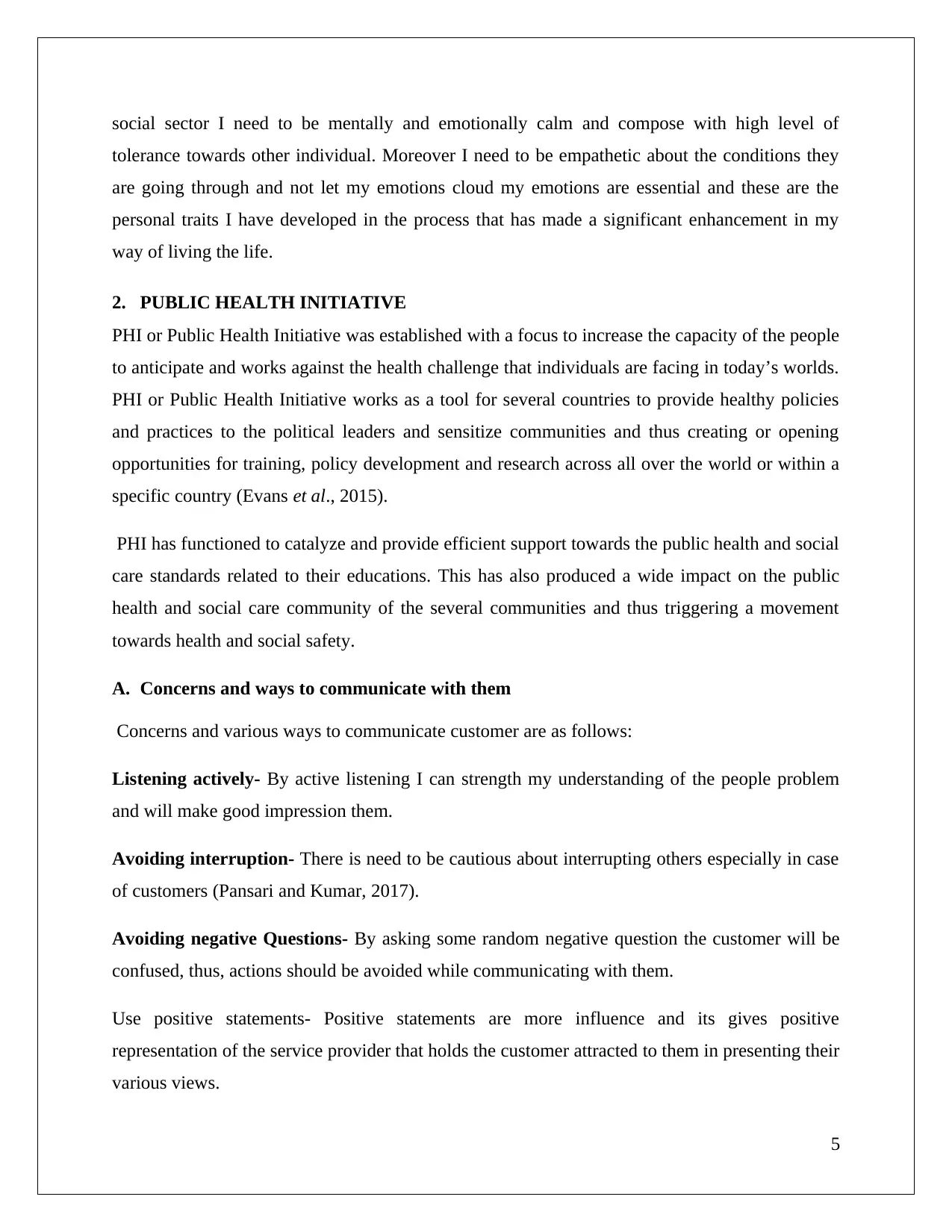
social sector I need to be mentally and emotionally calm and compose with high level of
tolerance towards other individual. Moreover I need to be empathetic about the conditions they
are going through and not let my emotions cloud my emotions are essential and these are the
personal traits I have developed in the process that has made a significant enhancement in my
way of living the life.
2. PUBLIC HEALTH INITIATIVE
PHI or Public Health Initiative was established with a focus to increase the capacity of the people
to anticipate and works against the health challenge that individuals are facing in today’s worlds.
PHI or Public Health Initiative works as a tool for several countries to provide healthy policies
and practices to the political leaders and sensitize communities and thus creating or opening
opportunities for training, policy development and research across all over the world or within a
specific country (Evans et al., 2015).
PHI has functioned to catalyze and provide efficient support towards the public health and social
care standards related to their educations. This has also produced a wide impact on the public
health and social care community of the several communities and thus triggering a movement
towards health and social safety.
A. Concerns and ways to communicate with them
Concerns and various ways to communicate customer are as follows:
Listening actively- By active listening I can strength my understanding of the people problem
and will make good impression them.
Avoiding interruption- There is need to be cautious about interrupting others especially in case
of customers (Pansari and Kumar, 2017).
Avoiding negative Questions- By asking some random negative question the customer will be
confused, thus, actions should be avoided while communicating with them.
Use positive statements- Positive statements are more influence and its gives positive
representation of the service provider that holds the customer attracted to them in presenting their
various views.
5
tolerance towards other individual. Moreover I need to be empathetic about the conditions they
are going through and not let my emotions cloud my emotions are essential and these are the
personal traits I have developed in the process that has made a significant enhancement in my
way of living the life.
2. PUBLIC HEALTH INITIATIVE
PHI or Public Health Initiative was established with a focus to increase the capacity of the people
to anticipate and works against the health challenge that individuals are facing in today’s worlds.
PHI or Public Health Initiative works as a tool for several countries to provide healthy policies
and practices to the political leaders and sensitize communities and thus creating or opening
opportunities for training, policy development and research across all over the world or within a
specific country (Evans et al., 2015).
PHI has functioned to catalyze and provide efficient support towards the public health and social
care standards related to their educations. This has also produced a wide impact on the public
health and social care community of the several communities and thus triggering a movement
towards health and social safety.
A. Concerns and ways to communicate with them
Concerns and various ways to communicate customer are as follows:
Listening actively- By active listening I can strength my understanding of the people problem
and will make good impression them.
Avoiding interruption- There is need to be cautious about interrupting others especially in case
of customers (Pansari and Kumar, 2017).
Avoiding negative Questions- By asking some random negative question the customer will be
confused, thus, actions should be avoided while communicating with them.
Use positive statements- Positive statements are more influence and its gives positive
representation of the service provider that holds the customer attracted to them in presenting their
various views.
5
⊘ This is a preview!⊘
Do you want full access?
Subscribe today to unlock all pages.

Trusted by 1+ million students worldwide
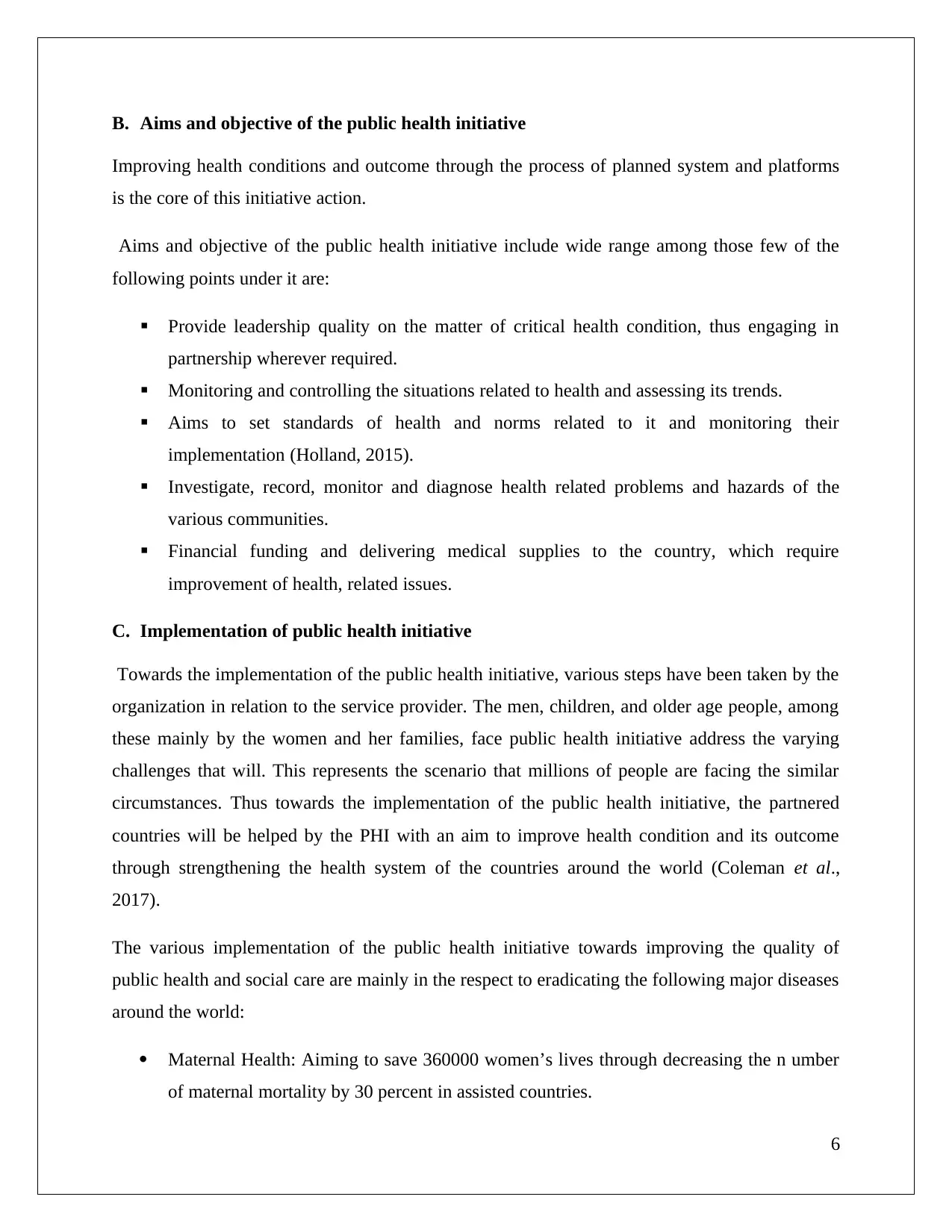
B. Aims and objective of the public health initiative
Improving health conditions and outcome through the process of planned system and platforms
is the core of this initiative action.
Aims and objective of the public health initiative include wide range among those few of the
following points under it are:
Provide leadership quality on the matter of critical health condition, thus engaging in
partnership wherever required.
Monitoring and controlling the situations related to health and assessing its trends.
Aims to set standards of health and norms related to it and monitoring their
implementation (Holland, 2015).
Investigate, record, monitor and diagnose health related problems and hazards of the
various communities.
Financial funding and delivering medical supplies to the country, which require
improvement of health, related issues.
C. Implementation of public health initiative
Towards the implementation of the public health initiative, various steps have been taken by the
organization in relation to the service provider. The men, children, and older age people, among
these mainly by the women and her families, face public health initiative address the varying
challenges that will. This represents the scenario that millions of people are facing the similar
circumstances. Thus towards the implementation of the public health initiative, the partnered
countries will be helped by the PHI with an aim to improve health condition and its outcome
through strengthening the health system of the countries around the world (Coleman et al.,
2017).
The various implementation of the public health initiative towards improving the quality of
public health and social care are mainly in the respect to eradicating the following major diseases
around the world:
Maternal Health: Aiming to save 360000 women’s lives through decreasing the n umber
of maternal mortality by 30 percent in assisted countries.
6
Improving health conditions and outcome through the process of planned system and platforms
is the core of this initiative action.
Aims and objective of the public health initiative include wide range among those few of the
following points under it are:
Provide leadership quality on the matter of critical health condition, thus engaging in
partnership wherever required.
Monitoring and controlling the situations related to health and assessing its trends.
Aims to set standards of health and norms related to it and monitoring their
implementation (Holland, 2015).
Investigate, record, monitor and diagnose health related problems and hazards of the
various communities.
Financial funding and delivering medical supplies to the country, which require
improvement of health, related issues.
C. Implementation of public health initiative
Towards the implementation of the public health initiative, various steps have been taken by the
organization in relation to the service provider. The men, children, and older age people, among
these mainly by the women and her families, face public health initiative address the varying
challenges that will. This represents the scenario that millions of people are facing the similar
circumstances. Thus towards the implementation of the public health initiative, the partnered
countries will be helped by the PHI with an aim to improve health condition and its outcome
through strengthening the health system of the countries around the world (Coleman et al.,
2017).
The various implementation of the public health initiative towards improving the quality of
public health and social care are mainly in the respect to eradicating the following major diseases
around the world:
Maternal Health: Aiming to save 360000 women’s lives through decreasing the n umber
of maternal mortality by 30 percent in assisted countries.
6
Paraphrase This Document
Need a fresh take? Get an instant paraphrase of this document with our AI Paraphraser
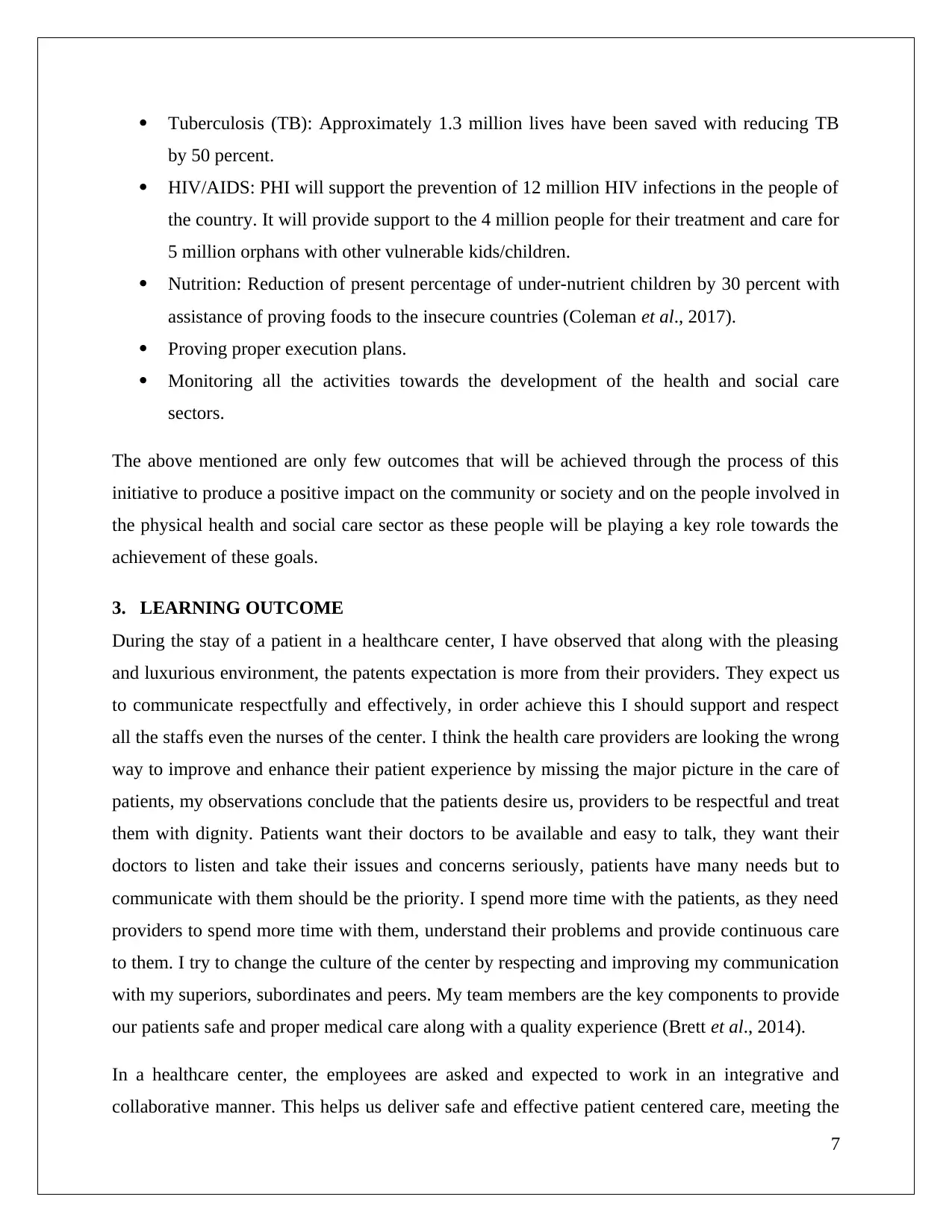
Tuberculosis (TB): Approximately 1.3 million lives have been saved with reducing TB
by 50 percent.
HIV/AIDS: PHI will support the prevention of 12 million HIV infections in the people of
the country. It will provide support to the 4 million people for their treatment and care for
5 million orphans with other vulnerable kids/children.
Nutrition: Reduction of present percentage of under-nutrient children by 30 percent with
assistance of proving foods to the insecure countries (Coleman et al., 2017).
Proving proper execution plans.
Monitoring all the activities towards the development of the health and social care
sectors.
The above mentioned are only few outcomes that will be achieved through the process of this
initiative to produce a positive impact on the community or society and on the people involved in
the physical health and social care sector as these people will be playing a key role towards the
achievement of these goals.
3. LEARNING OUTCOME
During the stay of a patient in a healthcare center, I have observed that along with the pleasing
and luxurious environment, the patents expectation is more from their providers. They expect us
to communicate respectfully and effectively, in order achieve this I should support and respect
all the staffs even the nurses of the center. I think the health care providers are looking the wrong
way to improve and enhance their patient experience by missing the major picture in the care of
patients, my observations conclude that the patients desire us, providers to be respectful and treat
them with dignity. Patients want their doctors to be available and easy to talk, they want their
doctors to listen and take their issues and concerns seriously, patients have many needs but to
communicate with them should be the priority. I spend more time with the patients, as they need
providers to spend more time with them, understand their problems and provide continuous care
to them. I try to change the culture of the center by respecting and improving my communication
with my superiors, subordinates and peers. My team members are the key components to provide
our patients safe and proper medical care along with a quality experience (Brett et al., 2014).
In a healthcare center, the employees are asked and expected to work in an integrative and
collaborative manner. This helps us deliver safe and effective patient centered care, meeting the
7
by 50 percent.
HIV/AIDS: PHI will support the prevention of 12 million HIV infections in the people of
the country. It will provide support to the 4 million people for their treatment and care for
5 million orphans with other vulnerable kids/children.
Nutrition: Reduction of present percentage of under-nutrient children by 30 percent with
assistance of proving foods to the insecure countries (Coleman et al., 2017).
Proving proper execution plans.
Monitoring all the activities towards the development of the health and social care
sectors.
The above mentioned are only few outcomes that will be achieved through the process of this
initiative to produce a positive impact on the community or society and on the people involved in
the physical health and social care sector as these people will be playing a key role towards the
achievement of these goals.
3. LEARNING OUTCOME
During the stay of a patient in a healthcare center, I have observed that along with the pleasing
and luxurious environment, the patents expectation is more from their providers. They expect us
to communicate respectfully and effectively, in order achieve this I should support and respect
all the staffs even the nurses of the center. I think the health care providers are looking the wrong
way to improve and enhance their patient experience by missing the major picture in the care of
patients, my observations conclude that the patients desire us, providers to be respectful and treat
them with dignity. Patients want their doctors to be available and easy to talk, they want their
doctors to listen and take their issues and concerns seriously, patients have many needs but to
communicate with them should be the priority. I spend more time with the patients, as they need
providers to spend more time with them, understand their problems and provide continuous care
to them. I try to change the culture of the center by respecting and improving my communication
with my superiors, subordinates and peers. My team members are the key components to provide
our patients safe and proper medical care along with a quality experience (Brett et al., 2014).
In a healthcare center, the employees are asked and expected to work in an integrative and
collaborative manner. This helps us deliver safe and effective patient centered care, meeting the
7
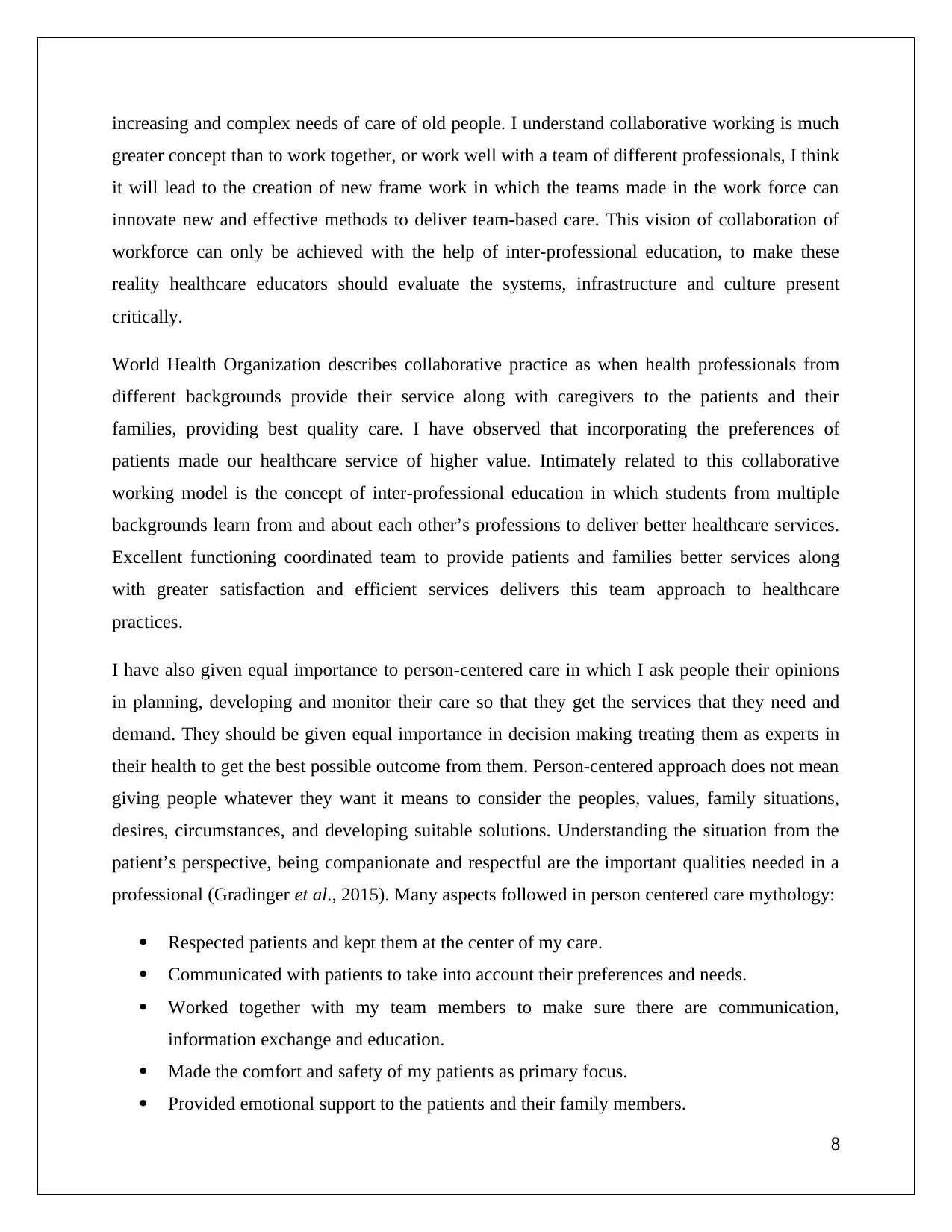
increasing and complex needs of care of old people. I understand collaborative working is much
greater concept than to work together, or work well with a team of different professionals, I think
it will lead to the creation of new frame work in which the teams made in the work force can
innovate new and effective methods to deliver team-based care. This vision of collaboration of
workforce can only be achieved with the help of inter-professional education, to make these
reality healthcare educators should evaluate the systems, infrastructure and culture present
critically.
World Health Organization describes collaborative practice as when health professionals from
different backgrounds provide their service along with caregivers to the patients and their
families, providing best quality care. I have observed that incorporating the preferences of
patients made our healthcare service of higher value. Intimately related to this collaborative
working model is the concept of inter-professional education in which students from multiple
backgrounds learn from and about each other’s professions to deliver better healthcare services.
Excellent functioning coordinated team to provide patients and families better services along
with greater satisfaction and efficient services delivers this team approach to healthcare
practices.
I have also given equal importance to person-centered care in which I ask people their opinions
in planning, developing and monitor their care so that they get the services that they need and
demand. They should be given equal importance in decision making treating them as experts in
their health to get the best possible outcome from them. Person-centered approach does not mean
giving people whatever they want it means to consider the peoples, values, family situations,
desires, circumstances, and developing suitable solutions. Understanding the situation from the
patient’s perspective, being companionate and respectful are the important qualities needed in a
professional (Gradinger et al., 2015). Many aspects followed in person centered care mythology:
Respected patients and kept them at the center of my care.
Communicated with patients to take into account their preferences and needs.
Worked together with my team members to make sure there are communication,
information exchange and education.
Made the comfort and safety of my patients as primary focus.
Provided emotional support to the patients and their family members.
8
greater concept than to work together, or work well with a team of different professionals, I think
it will lead to the creation of new frame work in which the teams made in the work force can
innovate new and effective methods to deliver team-based care. This vision of collaboration of
workforce can only be achieved with the help of inter-professional education, to make these
reality healthcare educators should evaluate the systems, infrastructure and culture present
critically.
World Health Organization describes collaborative practice as when health professionals from
different backgrounds provide their service along with caregivers to the patients and their
families, providing best quality care. I have observed that incorporating the preferences of
patients made our healthcare service of higher value. Intimately related to this collaborative
working model is the concept of inter-professional education in which students from multiple
backgrounds learn from and about each other’s professions to deliver better healthcare services.
Excellent functioning coordinated team to provide patients and families better services along
with greater satisfaction and efficient services delivers this team approach to healthcare
practices.
I have also given equal importance to person-centered care in which I ask people their opinions
in planning, developing and monitor their care so that they get the services that they need and
demand. They should be given equal importance in decision making treating them as experts in
their health to get the best possible outcome from them. Person-centered approach does not mean
giving people whatever they want it means to consider the peoples, values, family situations,
desires, circumstances, and developing suitable solutions. Understanding the situation from the
patient’s perspective, being companionate and respectful are the important qualities needed in a
professional (Gradinger et al., 2015). Many aspects followed in person centered care mythology:
Respected patients and kept them at the center of my care.
Communicated with patients to take into account their preferences and needs.
Worked together with my team members to make sure there are communication,
information exchange and education.
Made the comfort and safety of my patients as primary focus.
Provided emotional support to the patients and their family members.
8
⊘ This is a preview!⊘
Do you want full access?
Subscribe today to unlock all pages.

Trusted by 1+ million students worldwide
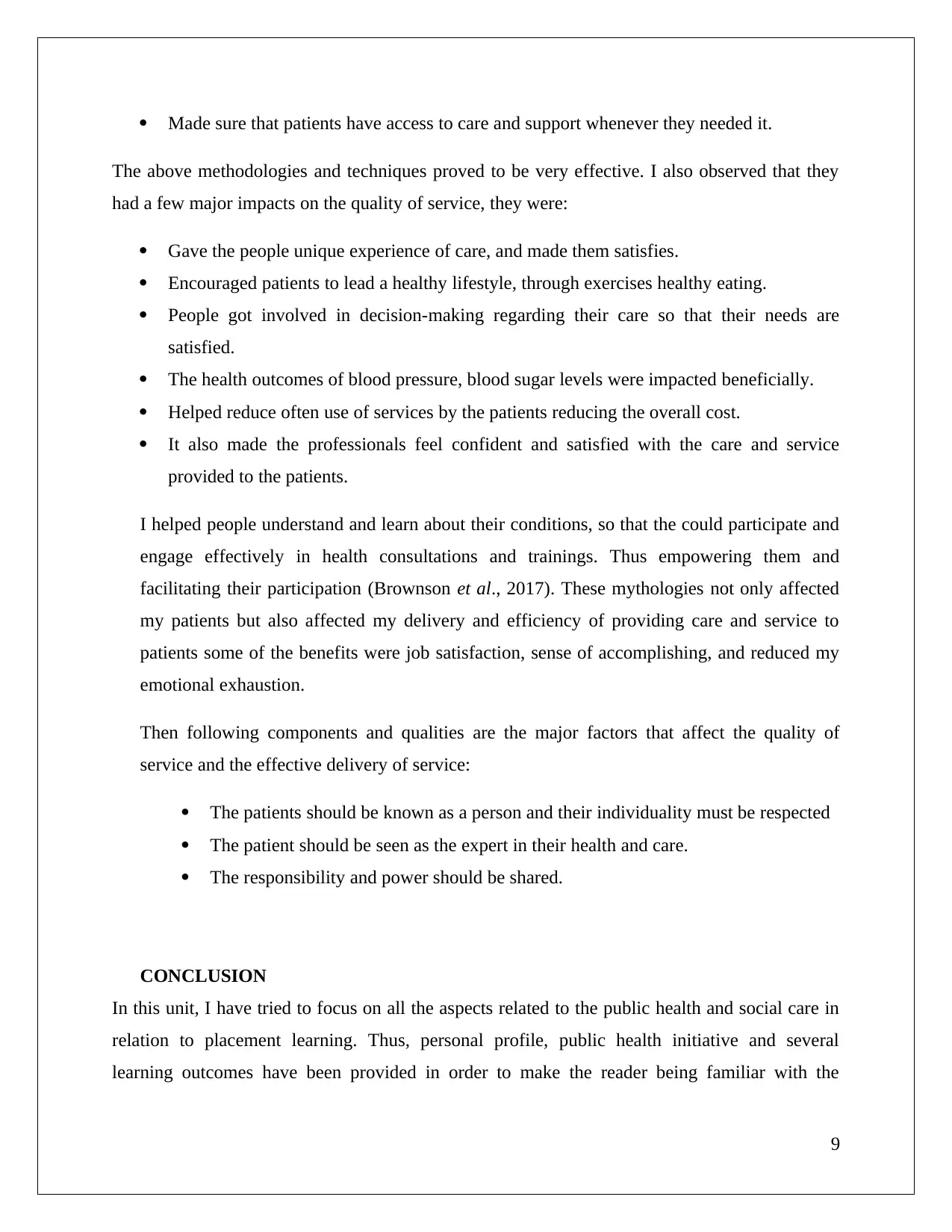
Made sure that patients have access to care and support whenever they needed it.
The above methodologies and techniques proved to be very effective. I also observed that they
had a few major impacts on the quality of service, they were:
Gave the people unique experience of care, and made them satisfies.
Encouraged patients to lead a healthy lifestyle, through exercises healthy eating.
People got involved in decision-making regarding their care so that their needs are
satisfied.
The health outcomes of blood pressure, blood sugar levels were impacted beneficially.
Helped reduce often use of services by the patients reducing the overall cost.
It also made the professionals feel confident and satisfied with the care and service
provided to the patients.
I helped people understand and learn about their conditions, so that the could participate and
engage effectively in health consultations and trainings. Thus empowering them and
facilitating their participation (Brownson et al., 2017). These mythologies not only affected
my patients but also affected my delivery and efficiency of providing care and service to
patients some of the benefits were job satisfaction, sense of accomplishing, and reduced my
emotional exhaustion.
Then following components and qualities are the major factors that affect the quality of
service and the effective delivery of service:
The patients should be known as a person and their individuality must be respected
The patient should be seen as the expert in their health and care.
The responsibility and power should be shared.
CONCLUSION
In this unit, I have tried to focus on all the aspects related to the public health and social care in
relation to placement learning. Thus, personal profile, public health initiative and several
learning outcomes have been provided in order to make the reader being familiar with the
9
The above methodologies and techniques proved to be very effective. I also observed that they
had a few major impacts on the quality of service, they were:
Gave the people unique experience of care, and made them satisfies.
Encouraged patients to lead a healthy lifestyle, through exercises healthy eating.
People got involved in decision-making regarding their care so that their needs are
satisfied.
The health outcomes of blood pressure, blood sugar levels were impacted beneficially.
Helped reduce often use of services by the patients reducing the overall cost.
It also made the professionals feel confident and satisfied with the care and service
provided to the patients.
I helped people understand and learn about their conditions, so that the could participate and
engage effectively in health consultations and trainings. Thus empowering them and
facilitating their participation (Brownson et al., 2017). These mythologies not only affected
my patients but also affected my delivery and efficiency of providing care and service to
patients some of the benefits were job satisfaction, sense of accomplishing, and reduced my
emotional exhaustion.
Then following components and qualities are the major factors that affect the quality of
service and the effective delivery of service:
The patients should be known as a person and their individuality must be respected
The patient should be seen as the expert in their health and care.
The responsibility and power should be shared.
CONCLUSION
In this unit, I have tried to focus on all the aspects related to the public health and social care in
relation to placement learning. Thus, personal profile, public health initiative and several
learning outcomes have been provided in order to make the reader being familiar with the
9
Paraphrase This Document
Need a fresh take? Get an instant paraphrase of this document with our AI Paraphraser
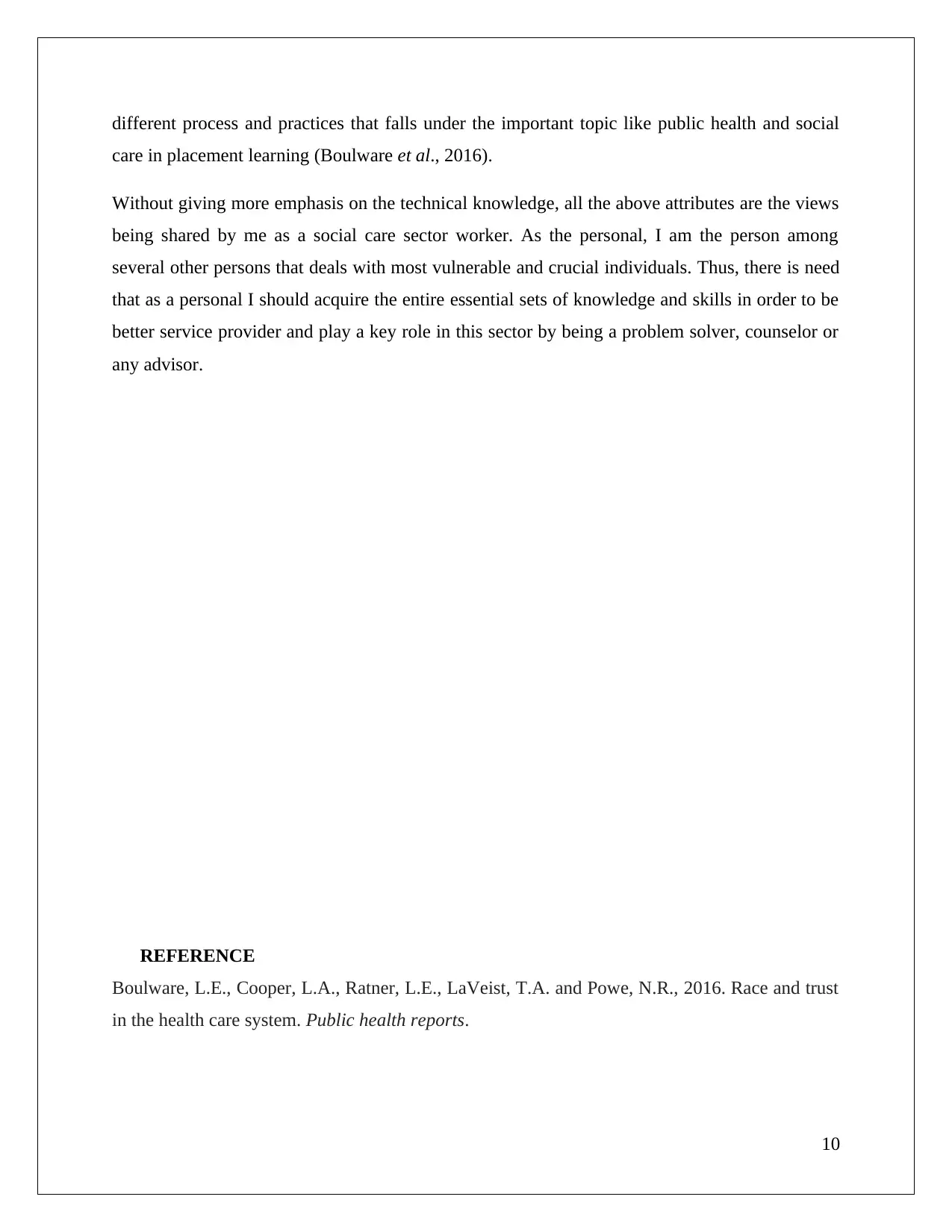
different process and practices that falls under the important topic like public health and social
care in placement learning (Boulware et al., 2016).
Without giving more emphasis on the technical knowledge, all the above attributes are the views
being shared by me as a social care sector worker. As the personal, I am the person among
several other persons that deals with most vulnerable and crucial individuals. Thus, there is need
that as a personal I should acquire the entire essential sets of knowledge and skills in order to be
better service provider and play a key role in this sector by being a problem solver, counselor or
any advisor.
REFERENCE
Boulware, L.E., Cooper, L.A., Ratner, L.E., LaVeist, T.A. and Powe, N.R., 2016. Race and trust
in the health care system. Public health reports.
10
care in placement learning (Boulware et al., 2016).
Without giving more emphasis on the technical knowledge, all the above attributes are the views
being shared by me as a social care sector worker. As the personal, I am the person among
several other persons that deals with most vulnerable and crucial individuals. Thus, there is need
that as a personal I should acquire the entire essential sets of knowledge and skills in order to be
better service provider and play a key role in this sector by being a problem solver, counselor or
any advisor.
REFERENCE
Boulware, L.E., Cooper, L.A., Ratner, L.E., LaVeist, T.A. and Powe, N.R., 2016. Race and trust
in the health care system. Public health reports.
10
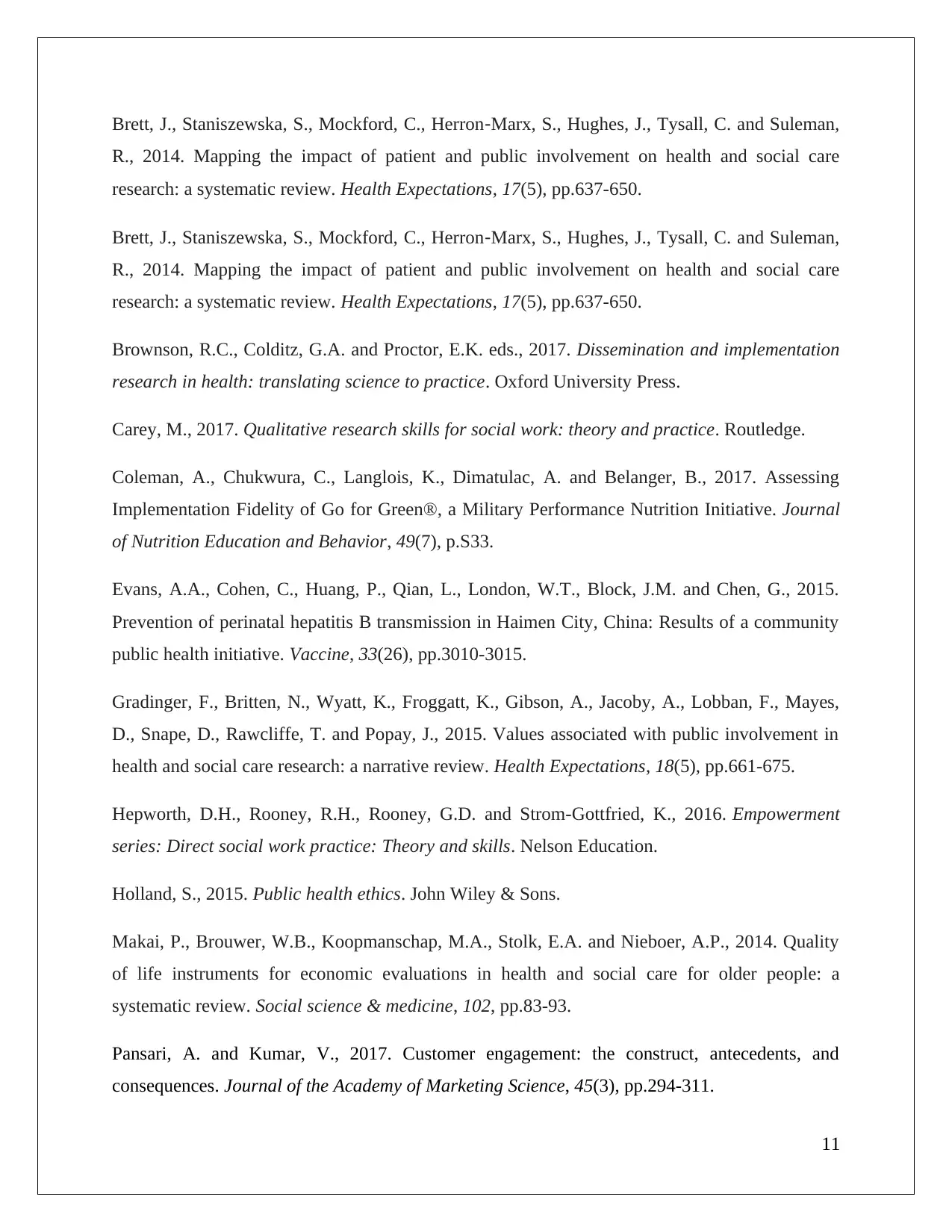
Brett, J., Staniszewska, S., Mockford, C., Herron‐Marx, S., Hughes, J., Tysall, C. and Suleman,
R., 2014. Mapping the impact of patient and public involvement on health and social care
research: a systematic review. Health Expectations, 17(5), pp.637-650.
Brett, J., Staniszewska, S., Mockford, C., Herron‐Marx, S., Hughes, J., Tysall, C. and Suleman,
R., 2014. Mapping the impact of patient and public involvement on health and social care
research: a systematic review. Health Expectations, 17(5), pp.637-650.
Brownson, R.C., Colditz, G.A. and Proctor, E.K. eds., 2017. Dissemination and implementation
research in health: translating science to practice. Oxford University Press.
Carey, M., 2017. Qualitative research skills for social work: theory and practice. Routledge.
Coleman, A., Chukwura, C., Langlois, K., Dimatulac, A. and Belanger, B., 2017. Assessing
Implementation Fidelity of Go for Green®, a Military Performance Nutrition Initiative. Journal
of Nutrition Education and Behavior, 49(7), p.S33.
Evans, A.A., Cohen, C., Huang, P., Qian, L., London, W.T., Block, J.M. and Chen, G., 2015.
Prevention of perinatal hepatitis B transmission in Haimen City, China: Results of a community
public health initiative. Vaccine, 33(26), pp.3010-3015.
Gradinger, F., Britten, N., Wyatt, K., Froggatt, K., Gibson, A., Jacoby, A., Lobban, F., Mayes,
D., Snape, D., Rawcliffe, T. and Popay, J., 2015. Values associated with public involvement in
health and social care research: a narrative review. Health Expectations, 18(5), pp.661-675.
Hepworth, D.H., Rooney, R.H., Rooney, G.D. and Strom-Gottfried, K., 2016. Empowerment
series: Direct social work practice: Theory and skills. Nelson Education.
Holland, S., 2015. Public health ethics. John Wiley & Sons.
Makai, P., Brouwer, W.B., Koopmanschap, M.A., Stolk, E.A. and Nieboer, A.P., 2014. Quality
of life instruments for economic evaluations in health and social care for older people: a
systematic review. Social science & medicine, 102, pp.83-93.
Pansari, A. and Kumar, V., 2017. Customer engagement: the construct, antecedents, and
consequences. Journal of the Academy of Marketing Science, 45(3), pp.294-311.
11
R., 2014. Mapping the impact of patient and public involvement on health and social care
research: a systematic review. Health Expectations, 17(5), pp.637-650.
Brett, J., Staniszewska, S., Mockford, C., Herron‐Marx, S., Hughes, J., Tysall, C. and Suleman,
R., 2014. Mapping the impact of patient and public involvement on health and social care
research: a systematic review. Health Expectations, 17(5), pp.637-650.
Brownson, R.C., Colditz, G.A. and Proctor, E.K. eds., 2017. Dissemination and implementation
research in health: translating science to practice. Oxford University Press.
Carey, M., 2017. Qualitative research skills for social work: theory and practice. Routledge.
Coleman, A., Chukwura, C., Langlois, K., Dimatulac, A. and Belanger, B., 2017. Assessing
Implementation Fidelity of Go for Green®, a Military Performance Nutrition Initiative. Journal
of Nutrition Education and Behavior, 49(7), p.S33.
Evans, A.A., Cohen, C., Huang, P., Qian, L., London, W.T., Block, J.M. and Chen, G., 2015.
Prevention of perinatal hepatitis B transmission in Haimen City, China: Results of a community
public health initiative. Vaccine, 33(26), pp.3010-3015.
Gradinger, F., Britten, N., Wyatt, K., Froggatt, K., Gibson, A., Jacoby, A., Lobban, F., Mayes,
D., Snape, D., Rawcliffe, T. and Popay, J., 2015. Values associated with public involvement in
health and social care research: a narrative review. Health Expectations, 18(5), pp.661-675.
Hepworth, D.H., Rooney, R.H., Rooney, G.D. and Strom-Gottfried, K., 2016. Empowerment
series: Direct social work practice: Theory and skills. Nelson Education.
Holland, S., 2015. Public health ethics. John Wiley & Sons.
Makai, P., Brouwer, W.B., Koopmanschap, M.A., Stolk, E.A. and Nieboer, A.P., 2014. Quality
of life instruments for economic evaluations in health and social care for older people: a
systematic review. Social science & medicine, 102, pp.83-93.
Pansari, A. and Kumar, V., 2017. Customer engagement: the construct, antecedents, and
consequences. Journal of the Academy of Marketing Science, 45(3), pp.294-311.
11
⊘ This is a preview!⊘
Do you want full access?
Subscribe today to unlock all pages.

Trusted by 1+ million students worldwide
1 out of 13
Related Documents
Your All-in-One AI-Powered Toolkit for Academic Success.
+13062052269
info@desklib.com
Available 24*7 on WhatsApp / Email
![[object Object]](/_next/static/media/star-bottom.7253800d.svg)
Unlock your academic potential
Copyright © 2020–2025 A2Z Services. All Rights Reserved. Developed and managed by ZUCOL.





